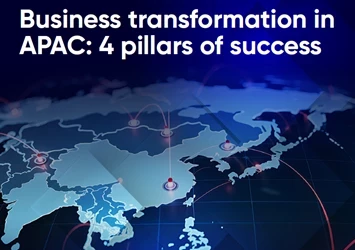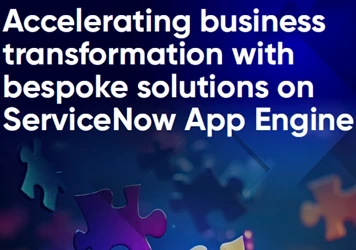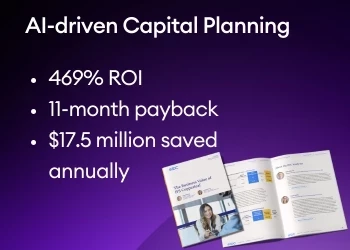Seven elements to focus on as the end of the financial year approaches (part 3)
Why companies should better understand their own principles of operations management and continuous improvement and how they approach transformation
Add bookmark
The first and second parts of this article series outlined the last-minute tactical solutions some function leaders often put in place as the end of the financial year (EOFY) approaches and the role of business transformation leaders in establishing a program of action to avoid chaos.
The third and final part of this articles series dives into how businesses can review their approach to transformation and how to leverage the Lean methodology to manage cost all year long.
The following illustration is aimed at establishing a business operating model by internalizing operations management, Lean, Agile and Six Sigma principles.

(Source: Nao Anthony)
This approach will help businesses avoid last-minute tactical solutions outlined in the first article of the series as the EOFY approaches for some regions.
This article examines the foundational principles of operations management and continuous improvement, focusing on the value chain for transformation and defining the cost of value delivered through value chains.
Examining the foundational principles of operations management and continuous improvement
How often do your products or services fail to meet your customers’ basic needs? Enterprise leaders often underestimate how much basic needs can change. What was once considered delightful can now be a threshold need.
I have witnessed organizations significantly invest in digital transformation where the delivery of basic needs is not addressed. Failing to understand how to fulfill them, especially considering market changes, may be detrimental to transformation efforts. These can in some instances transfer some of the process issues to customers which will negatively impact the market.
You need to be brilliant at basics, which includes having a sound understanding of the changes in customer needs and using agile ways of working to adapt your transformation to those. The operational ways of working that are deemed basic must be followed no matter what.
Below are some questions that can get function leaders to think about their own foundational principles of operations management:
- Do you consistently communicate the value your function offers to customers?
- Do you measure the effectiveness of your value chain using leading and lagging indicators?
- Are you promoting a culture which does not compromise on quality of the value offered?
- Do you engage upstream and downstream functions when solving value chain challengers?
- Have you created a safe environment in your function to bring problems to the surface?
- Have you established autonomy on daily operations management via visualization of performance?
- Do you leverage statistical analysis to forecast potential challengers in fluctuating demand and root causes?
- Are you and your company leaders measured on outcomes linked to the value offered to customers?
- Do you measure the effectiveness of your function holistically including elements like cost, strategy and transformation?
- Do you develop leaders who can do your role? Have you invested in people?
Below are some questions that can get function leaders to think about their own foundational principles of continuous improvement:
- Have you instilled a culture which has the autonomy to solve operational problems?
- Does your culture follow methodologies such as Lean, Sigma or plan, do, check, act (PDCA)?
- Are the visual management boards, huddles and problem-solving sessions fully effective and functional with autonomy?
- Is there a learning culture in your function?
- Is there a healthy competition between functions in the value chain in relation to operational excellence and continuous improvement?
- Are there formal channels created to harvest continuous improvement ideas that could influence your company’s transformation while eliminating customer pain points?
- Do you lead by example promoting a continuous improvement culture and the need of transforming the business?
- Do you celebrate success for both customers and colleagues?
As Peter Drucker said, “culture eats strategy for breakfast”. A leader who invests in people with the right attitude to create a growth mind-set will make their operational environment extremely easy to work for. The conventional model where employees follow leaders’ direction to take every step is proven to be unsustainable in today’s context.
Being brilliant at basic operational practices does not require a digitalized environment, but it needs the process thinking facilitated with autonomy and transparency.
Focusing on the value chain for transformation
We hear the word transformation more often in organizations than we did 10 years ago. Today’s leaders demand to transform their business’ operating model and digital footprint simultaneously, which means that increased investment demands faster payback.
While digitization improves businesses, it can also hinder them by creating new bottlenecks or increasing the speed of error generation when it is not executed rationally. The conventional process strategy speaks lots when it comes to the success of a digital transformation. Digitalizing a poor process will add complexity to it and to the customers by extensions and will result in a waste of money.
Related PEX Network report: Leveraging intelligent automation to link strategy with process improvement
Following the same value chain for transformation across an organization makes governance on investment objectives transparent and less complex. The two challenges for business leaders today are the limited funding for high-end technology solutions and the complexity around decision-making on transformation’s priority.
These could be simplified if the transformation’s investment and priority originate from the value stream. The ultimate question is what value is delivered through a transformation. We as operational excellence professionals must engage with business leaders to clarify value delivery and process thinking and in making decisions on the future of business transformation.
Below are some recommendations to consider before developing a business transformation roadmap:
- Define the value offering through the value chain to customers.
- State Voice of Customer (VoC) and demand – know where your customers are heading.
- Clearly articulate existing capabilities of end-to-end value chain – Lean principles will help you understand.
- Define challenges or problems faced by value chains together with the root causes – Six Sigma problem-solving approach will help uncover them.
- Understand resources and limitation such as financial, technologies, expertise, post-implementation support and operational time that are available in transforming the value chain.
- Define expectations for various technological and non-technological solution options.
- Engage end-to-end value chain leaders to prioritize solution options and their delivery method – utilize Agile methodology at a portfolio level.
As operational excellence professionals our role has become pivotal before, during and after a transformation. The role we play before the roadmap is endorsed is essential to the sustainability of the value chain.
We must ask questions to our leaders to reach a state of data rich environment that can help make an informed decision that include:
- How do you develop your business transformation portfolio? Is this by value chain function, project management office or customer need?
- What influences the business transformation roadmap?
- What role do business leaders play in the transformation and what is the role of operational excellence?
- How is funding executed? Is it a fixed model to draw upon value delivery or business case-based mechanism?
- How effective is the measure of success of the transformation and is it based on value?
- Is there a mechanism to assess the sustainability of a transformation program? How are the learnings shared?
- Does the transformation agenda consider predicators such as EOFY, peak seasons, potential campaigns and sales before finalizing timelines?
Critically defining the cost of “value” delivered through value chains
Profits are essential for businesses and it is crucial to understand how they come to existence. Customers pay for the perceived value delivered or offered to them but do organizations understand the actual cost of service or product offering? More often than not, the answer depends on the industry as I have observed the cost per service offering in the service industry to be much more complex than in manufacturing.
This difference could be due to complex pricing structures, grouping of service offerings or centralized operations. Nevertheless, to manage cost organizations need to find ways to measure it and as Peter Drucker is quoted as saying, “you can’t manage what you can’t measure”. Unfortunately, this statement is true in most cases.
Total cost is a lagging result measurement according to Lean methodology, which recommends a mix of leading and lagging indicators to manage organizational performance. Implementing a combination of result and driver measurements cascading from customer throughout the value chain will create an interlinked measurement system.
The idea is to manage the driver measurement, also known as the root causes, and the leading indicators that are close to real time. This will offer leaders the opportunity to influence the outcome. For example, measuring dynamic cycle time – the time elapsed to-date of a certain service offering before its delivery – will enable leaders to influence services or products before the service standards are breached compared to analyzing historical data which would be an in-retrospective chain of events.
The approach to measure the cost of a value is multifaceted but it can be divided in strategic and operational measures to capture the position of a value chain from a cost perspective, proactively, to make relevant decisions before it becomes significantly expensive. Below are some of the examples where periodical measuring could prevent unplanned major cost reduction programs.
Strategic cost measures:
- Total product or service contribution.
- Consolidated contribution of product/service mix.
- Percentage product or service (category) operational cost versus total product or service value chain cost.
- Product or service price versus actual cost.
- Customer-perceived price for value versus actual price.
- New product or service contribution prediction versus actual contribution.
- Predictive cost modelling versus actual cost on value chain, especially the cost of product or service.
- Cost of quality: percentage cost of quality in contribution.
- Cost of transformation versus total cost of service.
- Predictive correlation of cost of transformation versus sales or value chain cost reduction.
Operational cost measures:
- Value-added and non-value added cost ratio (categorized based on fixed and variable cost)
- Value chain cost mix with the help of Pareto on cost categories versus forecast.
- Unplanned cost such as overtime or contractor cost versus total cost against forecast.
- New campaigns of product or service costs versus forecast.
- Predictive operational cost modeling based on actual cost.
- Cost of operational transformation versus actual.
- Percentage cost of quality versus total cost of transformation.
Business transformation leaders have the potential to add significant value in relation to defining the landscape of cost for an organization and should focus on trends that will offer predictive insights of the future. The significant differences in conventional cost accounting approaches compared to Lean cost management approaches include the introduction of customer value when measuring cost. Leading indicators are usually used to manage the controllability of outcomes.
The advantage of collaboration extends the strategic insights that can be provided to the relevant operational and product or service leaders. Effective governance of those measures means that the results are predictive in nature toward EOFY, which is another moment in time for leaders to measure where their business is at.
Strategic product leaders:
- Measure how effective is your ability to translate VoC to sustainable products or services.
- Proactively measure the perceived value and actual value offered to customers.
- Use predictive insights to define what business transformation should mean to customers and how it impacts the organization.
- Make strategic decisions on the sustainability of cost of product or service compared to the price customers pay.
- Measure the effectiveness of product leadership from an individual perspective and obtain relevant coaching and mentoring to be effective leaders.
Strategic operational leaders:
- Measure the effectiveness of the operational cost profile (cost of product or service) in order to influence product and transformation leaders on opportunities that exist for corrective actioning.
- Understand your position on the cost of quality and invest to significantly reduce defects or rework throughout the value chain.
- Collaborate with product and business transformation leaders to assess the operating model and its ‘fit for purpose’. Remove organizational barriers that inhibit the ability of delivering value to customers.
- Measure the effectiveness of operational leadership from an individual perspective and obtain relevant coaching and mentoring to be effective leaders.
Business transformation leaders:
- Collaborate with strategic product and operational leaders to uncover opportunities that could enhance value to customers.
- Facilitate strategy sessions with leaders to define the transformation roadmap aimed at impacting customer value.
- Mentor and coach leaders on making the existing measurement system effective and offer value to leaders in making decisions.
- Assess the opportunities within the organization to invest in thought leadership to create autonomy in management, especially from a transformation standpoint.
- Benchmark other industries to understand the latest trends and practices that are aimed at agile customer value delivery.
- Measure the effectiveness of business transformation leadership to acknowledge gaps in skills and capabilities required to lead organizational transformation.
Conclusion
Business transformation or operational excellence in its purest form is not about establishing a plan which will reduce headcount, or introduce a new technology or an operating model. These could be the outcomes but they should not be the primary objective.
Operational excellence should influence the value-add to customers or stakeholders. The building blocks of operational excellence will enable a process strategy to govern how value is created across the value chains. Adherence to a process strategy will cultivate process thinking in leaders and will result in a business being the best at basics while having focus on changing customer demands. These could relate to operations management, projects and programs, cost management or organizational strategy.
In my experience, EOFY tactical actions I discussed in the first part of this article series are inevitable when businesses do not meet basics in operating a business and it is interestingly very often not about the performance of the people or their outcomes.
















